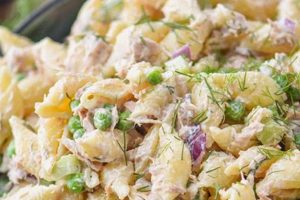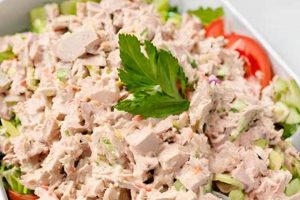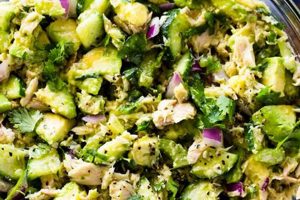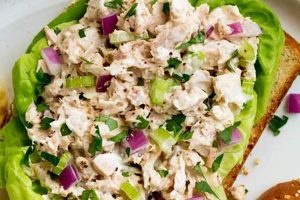A superior tuna macaroni salad involves a harmonious blend of high-quality ingredients and careful preparation. This encompasses perfectly cooked pasta, premium tuna, crisp vegetables, and a flavorful dressing that complements the other components without overpowering them. An exemplary version might include celery, red onion, and a creamy, tangy mayonnaise-based dressing, perhaps enhanced with Dijon mustard, sweet pickle relish, or a touch of lemon juice.
Achieving a well-balanced and delicious salad offers numerous advantages. It provides a satisfying and nutritious meal or side dish, suitable for picnics, potlucks, and everyday lunches. A well-executed recipe can elevate a simple dish to a crowd-pleasing favorite. Historically, macaroni salads have been a popular and adaptable dish, reflecting evolving culinary trends and regional preferences. Variations abound, demonstrating the dish’s flexibility and enduring appeal.
The following sections will explore key elements contributing to a successful outcome. These include selecting the right pasta, choosing the best tuna, incorporating complementary vegetables, and crafting a dressing that ties all the flavors together harmoniously. Tips and techniques for optimal preparation and presentation will also be addressed.
Tips for an Exceptional Tuna Macaroni Salad
Creating a truly memorable tuna macaroni salad hinges on attention to detail and thoughtful ingredient selection. The following tips offer guidance for achieving optimal results.
Tip 1: Pasta Perfection: Opt for small pasta shapes like elbow macaroni, shells, or rotini. Cook pasta al dente to maintain a firm texture and prevent a mushy salad. Rinse cooked pasta under cold water to stop the cooking process and cool it quickly.
Tip 2: Tuna Selection: High-quality tuna packed in water or oil significantly impacts flavor. Solid or chunk light tuna generally works well. Drain the tuna thoroughly before adding it to the salad.
Tip 3: Vegetable Enhancement: Finely diced celery and red onion are classic additions. Consider incorporating other vegetables like chopped bell peppers, shredded carrots, or chopped pickles for added flavor and texture. Blanching certain vegetables before adding them can enhance both their color and flavor.
Tip 4: Dressing Mastery: A well-balanced dressing is essential. Mayonnaise serves as a foundation, often complemented by Dijon mustard, sweet pickle relish, apple cider vinegar, or lemon juice. Seasoning with salt, black pepper, and paprika enhances the overall flavor profile.
Tip 5: Flavor Balance: Taste and adjust seasonings as needed. Achieving the right balance of creamy, tangy, and savory elements is key to a delicious salad.
Tip 6: Chilling Time: Allow the salad to chill for at least 30 minutes before serving. This allows the flavors to meld and the salad to reach an optimal temperature.
Tip 7: Presentation Matters: Garnish the salad with fresh herbs like parsley or dill before serving for an added touch of freshness and visual appeal.
By following these tips, one can elevate a simple tuna macaroni salad to a culinary masterpiece. Attention to these details ensures a dish that is both flavorful and visually appealing.
By incorporating these insights, culinary success is well within reach. The following conclusion will summarize key takeaways and offer final recommendations for creating a memorable dish.
1. High-quality Ingredients
Ingredient quality significantly impacts the overall flavor and enjoyment of tuna macaroni salad. Superior ingredients elevate this simple dish, transforming it from ordinary to exceptional. Utilizing premium components contributes to a more satisfying and flavorful culinary experience. The following facets explore the importance of ingredient selection in crafting the best possible tuna macaroni salad.
- Tuna Selection:
Opting for high-quality tuna packed in water or oil, rather than an inexpensive, heavily processed variety, significantly affects the final flavor. Solid or chunk light tuna generally offers the best texture and taste. Draining the tuna thoroughly before incorporating it into the salad prevents excess liquid from diluting the dressing.
- Mayonnaise Matters:
Utilizing a premium mayonnaise contributes a rich, creamy texture and enhances the overall flavor profile. Consider using mayonnaise made with real eggs and avoiding low-fat or artificial substitutes for optimal results.
- Fresh Produce:
Incorporating crisp, fresh vegetables enhances the salad’s texture, flavor, and visual appeal. Wilted or less-than-fresh produce detracts from the final product. Opting for vibrant, recently harvested vegetables, such as celery, red onion, and bell peppers, elevates the overall quality.
- Pasta Choice:
Selecting a high-quality pasta, ideally made from durum wheat, ensures optimal texture and prevents the pasta from becoming overly mushy when combined with the other ingredients. Cooking the pasta al dente is crucial, as overcooked pasta will result in a less appealing final product.
By focusing on high-quality ingredients, one can elevate tuna macaroni salad from a simple side dish to a truly memorable culinary creation. The careful selection of each component contributes significantly to the overall taste, texture, and enjoyment of the dish. Prioritizing quality in ingredient selection ensures a superior final product.
2. Proper Pasta Cooking
Proper pasta cooking is crucial for a best tuna macaroni salad recipe. The pasta’s texture significantly impacts the overall enjoyment of the dish. Overcooked pasta results in a mushy, unappetizing salad, while undercooked pasta offers an unpleasant, firm bite. Achieving perfectly cooked pasta provides a pleasant textural counterpoint to the other ingredients, enhancing the salad’s overall appeal. The following facets explore the nuances of proper pasta cooking in the context of tuna macaroni salad.
- Al Dente Consistency:
Cooking pasta “al dente,” meaning “to the tooth” in Italian, is essential. This state is achieved when the pasta offers slight resistance when bitten but is not hard or crunchy. Overcooked pasta absorbs too much water, resulting in a mushy texture that negatively impacts the salad. Al dente pasta maintains its shape and provides a pleasant chewiness within the salad.
- Salted Boiling Water:
Generously salting the boiling water seasons the pasta from the inside out. This foundational seasoning enhances the pasta’s flavor and complements the other ingredients in the salad. Unsalted pasta can taste bland, detracting from the overall flavor profile of the dish.
- Appropriate Cooking Time:
Following the package directions for cooking time is a good starting point, but it’s essential to test the pasta for doneness frequently. Cooking time can vary based on factors like pasta shape and altitude. Regularly checking the pasta ensures it reaches the desired al dente consistency without overcooking.
- Rinsing and Cooling:
Rinsing the cooked pasta under cold water immediately after draining stops the cooking process and removes excess starch. This step prevents the pasta from sticking together and helps maintain a desirable texture within the salad. Cooling the pasta quickly also prevents it from absorbing excess dressing, which can lead to a soggy salad.
Mastering proper pasta cooking techniques significantly elevates tuna macaroni salad. Achieving al dente pasta, seasoning it properly, and cooling it quickly contribute to a final product with a pleasing texture and enhanced flavor. These steps ensure the pasta complements the other ingredients without becoming a mushy or bland element within the dish. Attention to these details elevates the overall culinary experience.
3. Flavorful Dressing
A flavorful dressing is paramount in a best tuna macaroni salad recipe. It serves as the unifying element, binding the ingredients and imparting a cohesive flavor profile. A bland or unbalanced dressing can render the salad unappetizing, while a well-crafted dressing elevates the dish to a culinary delight. The following facets explore the crucial role of a flavorful dressing in creating an exceptional tuna macaroni salad.
- Balancing Creamy and Tangy Elements:
The foundation of most tuna macaroni salad dressings is mayonnaise, which provides a rich, creamy texture. However, relying solely on mayonnaise can result in a heavy, overly rich salad. Incorporating tangy elements, such as lemon juice, apple cider vinegar, or Dijon mustard, balances the creaminess and adds brightness to the flavor profile. This balance prevents the dressing from being overpowering and allows the other ingredients to shine.
- Seasoning and Flavor Enhancement:
Proper seasoning is crucial for a flavorful dressing. Salt and freshly ground black pepper are essential, but other seasonings can further enhance the flavor complexity. Paprika, garlic powder, onion powder, or celery seed can add subtle depth and complexity. A touch of sugar or a pinch of cayenne pepper can also contribute to a more well-rounded flavor profile. Tasting and adjusting the seasoning throughout the process ensures a balanced and flavorful outcome.
- Complementary Flavor Combinations:
The dressing should complement the other ingredients in the salad, not overpower them. Consider the flavors of the tuna, vegetables, and any other additions when selecting seasonings and flavoring agents. For example, a dill-based dressing might pair well with a salad containing cucumbers and fresh dill, while a sweeter dressing might complement a salad with chopped apples or grapes.
- Emulsification and Texture:
A well-emulsified dressing is essential for a smooth, creamy texture. Properly combining the ingredients, typically by whisking or blending, ensures the dressing doesn’t separate or become watery. A stable emulsion also helps coat the pasta and other ingredients evenly, distributing the flavor throughout the salad. Attention to emulsification contributes to a more visually appealing and palatable final product.
A well-executed dressing elevates tuna macaroni salad from a simple side dish to a star attraction. Balancing creamy and tangy elements, incorporating appropriate seasonings, considering complementary flavors, and achieving a stable emulsion are crucial components in crafting a dressing that complements the other ingredients and enhances the overall culinary experience. Careful attention to these details distinguishes a truly exceptional tuna macaroni salad.
4. Complementary Vegetables
Complementary vegetables play a crucial role in a best tuna macaroni salad recipe, contributing texture, flavor, and visual appeal. Thoughtful vegetable selection elevates the salad from simple to exceptional, offering a more nuanced and satisfying culinary experience. Beyond the classic celery and red onion, a variety of vegetables can enhance the salad’s overall profile, adding depth and complexity.
- Textural Contrast:
Vegetables provide crucial textural contrast to the softness of the pasta and tuna. Crisp vegetables like celery, bell peppers, and chopped water chestnuts offer a satisfying crunch, while softer vegetables like blanched green beans or chopped cucumbers provide a subtle textural variation. This interplay of textures prevents the salad from becoming monotonous and enhances its overall appeal.
- Flavor Enhancement:
Different vegetables contribute unique flavor profiles that complement the tuna and dressing. Sweet bell peppers offer a mild sweetness, while red onion adds a pungent bite. Chopped pickles or capers introduce a briny, salty note, and fresh herbs like parsley or dill provide a refreshing herbal element. These varied flavors create a more complex and interesting salad.
- Visual Appeal:
Brightly colored vegetables enhance the visual appeal of tuna macaroni salad. Red bell peppers, green celery, and orange carrots add vibrant pops of color, making the salad more visually appealing. This visual element contributes to a more enjoyable dining experience.
- Nutritional Value:
Incorporating a variety of vegetables increases the nutritional value of the salad. Vegetables provide essential vitamins, minerals, and fiber, transforming a simple side dish into a more nutritious meal option. This nutritional boost adds another layer of benefit to a well-crafted tuna macaroni salad.
The strategic inclusion of complementary vegetables significantly impacts the overall quality of tuna macaroni salad. By considering textural contrast, flavor enhancement, visual appeal, and nutritional value, one can create a salad that is not only delicious but also offers a more complex and satisfying culinary experience. A thoughtful combination of vegetables elevates this classic dish to new heights.
5. Appropriate Chilling Time
Appropriate chilling time is a crucial factor in achieving a best tuna macaroni salad recipe. Chilling allows the flavors of the various ingredientsthe tuna, vegetables, pasta, and dressingto meld and harmonize, resulting in a more cohesive and flavorful final product. Insufficient chilling can lead to a bland, disjointed salad, while excessive chilling can negatively impact the texture of certain ingredients. Understanding the role of chilling time contributes significantly to crafting a superior tuna macaroni salad.
- Flavor Development:
Chilling allows the flavors of the individual ingredients to meld and mature. The dressing absorbs into the pasta, and the flavors of the tuna, vegetables, and seasonings permeate the entire salad. This fusion of flavors creates a more complex and nuanced taste profile that is greater than the sum of its parts. A freshly made salad, while palatable, lacks the depth of flavor achieved through proper chilling.
- Temperature and Palatability:
A chilled tuna macaroni salad is more refreshing and palatable, particularly in warmer weather. The cool temperature enhances the creamy texture of the dressing and provides a welcome contrast to the often-rich flavors of the tuna and other ingredients. Serving the salad at the appropriate temperature maximizes enjoyment and contributes to a more satisfying dining experience.
- Texture Optimization:
Chilling can also positively impact the texture of the salad. The pasta firms up slightly as it chills, preventing it from becoming mushy. The chilling process also allows the dressing to thicken slightly, further enhancing the overall texture and preventing a watery or runny salad. However, excessive chilling can make some vegetables, like cucumbers, lose their crispness.
- Food Safety:
Proper chilling is essential for food safety, especially for salads containing mayonnaise-based dressings. Chilling inhibits the growth of bacteria that can cause foodborne illness. Maintaining the salad at a safe temperature below 40F (4C) is crucial for protecting against bacterial contamination and ensuring the salad remains safe to consume.
Appropriate chilling time is an essential, often overlooked, element in creating a best tuna macaroni salad recipe. It contributes significantly to flavor development, enhances palatability, optimizes texture, and ensures food safety. By allowing sufficient time for the flavors to meld and the salad to reach an optimal temperature, one elevates this simple dish to a truly exceptional culinary experience. Understanding the impact of chilling time is a key component in mastering the art of tuna macaroni salad preparation.
6. Thoughtful Presentation
While flavor and texture are paramount in a best tuna macaroni salad recipe, thoughtful presentation elevates the dish from merely satisfying to truly memorable. Visual appeal significantly enhances the dining experience, stimulating appetite and adding a touch of elegance to even a simple dish. Consideration of presentation demonstrates care and attention to detail, transforming the salad into a more polished and inviting culinary creation.
- Serving Dish Selection:
The choice of serving dish plays a significant role in the overall presentation. A clear glass bowl showcases the vibrant colors of the salad and allows the textures to be fully appreciated. Alternatively, a shallow platter provides a wider surface area, facilitating even cooling and allowing for more creative arrangements. The serving dish should complement the salad’s aesthetic and the occasion.
- Garnishing Techniques:
Strategic garnishing adds a touch of elegance and freshness. Fresh herbs, such as sprigs of dill or parsley, provide a vibrant green accent and complement the flavors of the salad. A sprinkle of paprika or a dusting of chopped chives adds visual interest and subtle flavor enhancement. Garnishes should be used sparingly, enhancing the presentation without overpowering the salad.
- Portioning and Plating:
Careful portioning ensures an appealing presentation and facilitates even distribution of ingredients. Using an ice cream scoop or a large spoon creates uniform portions, adding a professional touch. For individual servings, consider plating the salad on a bed of lettuce or alongside complementary dishes. Thoughtful plating elevates the dining experience.
- Contextual Considerations:
The presentation should align with the context of the meal. For a casual picnic, a simple, rustic presentation might suffice. For a more formal occasion, a more elaborate presentation, incorporating elegant servingware and meticulous garnishing, might be appropriate. Adapting the presentation to the setting enhances the overall dining experience.
Thoughtful presentation elevates tuna macaroni salad from a simple dish to a culinary statement. By considering the serving dish, garnishing techniques, portioning, and the overall context, one can transform a basic salad into a visually appealing and memorable culinary creation. Attention to these details demonstrates care and enhances the overall enjoyment of the dish, contributing significantly to the “best” designation.
Frequently Asked Questions
This section addresses common inquiries regarding optimal tuna macaroni salad preparation, offering concise and informative responses to facilitate culinary success.
Question 1: What type of tuna is best suited for macaroni salad?
Solid or chunk light tuna packed in water or oil generally yields the best results. Oil-packed tuna adds richness, while water-packed tuna offers a leaner option. Avoid tuna packed in “broth” or “sauce,” as these can impart undesirable flavors.
Question 2: How can one prevent the salad from becoming too watery?
Thoroughly draining both the tuna and any other canned or jarred ingredients, such as pickles or pimientos, helps prevent excess liquid from accumulating in the salad. Ensuring the pasta is well-drained and cooled also minimizes water content.
Question 3: What can be substituted for celery if it is unavailable or disliked?
Finely diced fennel, chopped water chestnuts, or diced jicama can provide a similar textural element and a distinct flavor profile. Chopped bell peppers also offer a crisp, refreshing alternative.
Question 4: How long can tuna macaroni salad be stored safely?
Properly stored in an airtight container in the refrigerator, tuna macaroni salad typically remains safe to consume for three to five days. Always discard the salad if it develops an off odor, unusual appearance, or slimy texture.
Question 5: Can other seasonings be added to the dressing?
Experimenting with various seasonings can enhance the flavor profile. Consider adding dill, chives, paprika, garlic powder, or onion powder. A touch of sweetness from a small amount of sugar or honey can balance the tangy elements.
Question 6: How can the nutritional value of the salad be increased?
Incorporating a variety of vegetables, such as chopped bell peppers, shredded carrots, or chopped broccoli florets, boosts the salad’s nutritional content. Adding protein-rich ingredients, like hard-boiled eggs or chickpeas, further enhances its nutritional value.
Addressing these common inquiries ensures a well-informed approach to tuna macaroni salad preparation, contributing to a more successful and enjoyable culinary outcome.
The following section offers a concise conclusion, summarizing key takeaways and providing final recommendations for achieving tuna macaroni salad excellence.
Conclusion
Crafting a truly exceptional tuna macaroni salad involves a multifaceted approach, encompassing careful ingredient selection, precise cooking techniques, and thoughtful presentation. High-quality tuna, perfectly cooked pasta, and a well-balanced dressing form the foundation of this culinary endeavor. Complementary vegetables contribute textural and flavor complexity, while appropriate chilling time allows the flavors to meld harmoniously. Attention to these details elevates this simple dish beyond the ordinary.
Culinary exploration yields rewarding results. Experimentation with various ingredients, seasonings, and presentation styles allows for personalized interpretations and the discovery of unique flavor profiles. The pursuit of the “best” tuna macaroni salad recipe is an ongoing journey, driven by individual preferences and a passion for culinary excellence. This pursuit encourages creativity and elevates a classic dish to new heights of gastronomic enjoyment.






